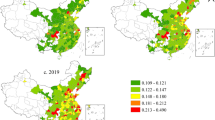Abstract
Tourism sector is now considered as a harbinger of inclusive growth, especially after recognising its potential in generating employment (both directly and indirectly). Indian tourism industry contributes around 7.5 per cent towards employment. This paper aims at analysing the role of tourism industry in generating employment. Input–output method has been used to derive the employment multiplier and hence through this we endeavour to estimate the employment generated in tourism sector as a result of one additional unit of foreign tourist expenditures. Our results reveal that foreign tourist expenditure has a positive impact on the tourism sector by boosting employment generation both directly and indirectly. Based on the results obtained, this paper bears various policy implications.

Source: WTTC (2013)
Similar content being viewed by others
References
Armstrong, W. E., S. Daniel and A. A. Francis (1974), “A Structural Analysis of the Barbados Economy, 1968, with an Application to the Tourist Industry”, Social Economic Studies, Vol. 22, No. 4, pp. 493–520.
Ashworth, J. (1999), “Patterns of Seasonality in Employment in Tourism in the UK”, Applied Economics Letters, Vol. 6, No. 11, pp. 735–40.
Brenner, L. and A. G. Aguilar (2002), “Luxury Tourism and Regional Economic Development in Mexico”, The Professional Geographer, Vol. 54, No. 4, pp. 500–20.
Burkart, A. and S. Medlik (1992), Tourism: Past, Present and Future, Heinemann, London.
Cheong, W. M. (2009), “Employment Characteristics and Trends of Tourism-related Industries”, Macao Monetary research Bulletin, October, Issue No. 13, pp. 67–89.
CSO (2012), Input Output Transaction Table 2007–08, Central Statistical Organisation, New Delhi.
ESCAP (1992), Economic Impact of Tourism in India, Economic and Social Commission for Asia and the Pacific, United Nations, New York.
ESCAP (1996), Economic Impact of Tourism in the Asian Region, Economic and Social Commission for Asia and the Pacific, United Nations, New York.
Eurostat (2008), Statistics in Focus, Issue No. 90/2008.
Holloway, J. C. (1994), The Business of Tourism, Addison Wesley Longman ltd, London, Ireland.
ILO (2003), “Employment and Human Resources in the Tourist Industry in Asia and The Pacific Sectoral”, Sectoral Working Paper No. 204, International Labour Organization, Geneva.
Laurence, F. H. (1980), “Specialization in Service Industry Employment as a State Policy”, Growth & Change, Vol. 11, No. 4 pp. 18–24.
MOT (2006), International Passenger Survey 2003, Ministry of Tourism, Government of India, New Delhi.
NCAER (2006), Tourism Satellite Account for India, National Council for Applied Economic Research, New Delhi.
NSSO (2011), “Employment and Unemployment Situation in India 2009–2010”, Report No. 537, National Sample Survey Organisation, New Delhi.
Önder, K. and Ayşe, D. (2008), “Effects of Tourism Sector on the Employment in Turkey: An Econometric Application”, Proceedings Book First International Conference on Management and Economics (ICME’08), Current Issues in Emerging Economies in Global Perspective, University of Tirana, Albania, pp. 365–37.
Saayman, M. and E. Slabbert (2001), “Tourism Entrepreneurs: Opportunities and Threats, A South African Perspective”, 46th International Council For Small Business, Tapei.
Strizzi, N and S. Meis (2001), “Challenges Facing Tourism Markets in Latin America and the Caribbean Region in the New Millennium”, Journal of Travel Research, Vol. 40, No. 2, pp. 183–92.
United Nations Statistical Division (2007), “2008 International Recommendations for Tourism Statistics”, http://unstats.un.org/unsd/statcom/doc08/BG-TourismStats.pdf, Accessed on 17 November 2014.
Walter, G. (1957), “Trends in Employment in the Service Industries”, American Economic Reviews, Vol. 47, No. 3, pp. 482–86.
WTTC (2009), “Tourism Research: Economic Data”, World Travel and Tourism Council, London, http://www.wttc.org/research, Accessed on 11 August 2013.
WTTC (2013), “Tourism Research: Economic Data”, World Travel and Tourism Council, London, http://www.etoa.org/docs/default-source/Reports/other-reports/2013-travel-tourism-economic-impact-by-wttc.pdf?sfvrsn=0 search tool/, Accessed on 26 June 2014.
Author information
Authors and Affiliations
Corresponding author
Rights and permissions
About this article
Cite this article
Prasad, N., Kulshrestha, M. Employment generation in tourism industry: an input–output analysis. Ind. J. Labour Econ. 58, 563–575 (2015). https://doi.org/10.1007/s41027-016-0035-2
Published:
Issue Date:
DOI: https://doi.org/10.1007/s41027-016-0035-2




